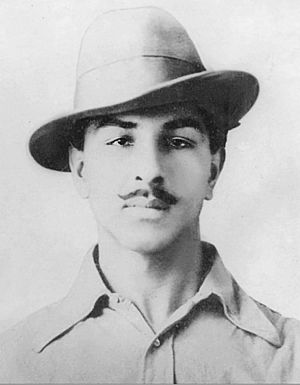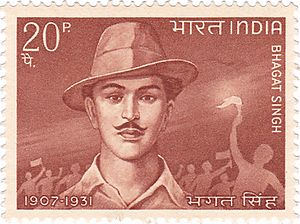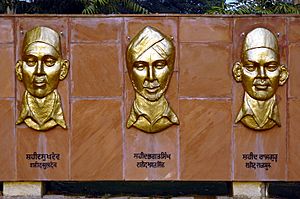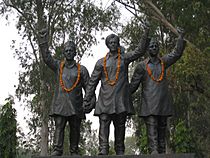Bhagat Singh facts for kids
Quick facts for kids
Bhagat Singh
|
|
|---|---|

Singh in 1929
|
|
| Born | 27 September 1907 Banga, Lyallpur District, Punjab Province, British India
(present-day Faisalabad District, Punjab, Pakistan) |
| Died | 23 March 1931 (aged 23) Lahore Central Jail, Lahore, Punjab Province, British India
(present-day Lahore District, Punjab, Pakistan) |
| Cause of death | Execution by hanging |
| Monuments | Hussainiwala National Martyrs Memorial |
| Other names | Shaheed-e-Azam |
| Organization | Naujawan Bharat Sabha Hindustan Socialist Republican Association |
|
Notable work
|
Why I Am an Atheist |
| Movement | Indian independence movement |
| Criminal charge(s) | Murder of John P. Saunders and Channan Singh |
| Criminal penalty | Capital punishment |
| Criminal status | Executed |
| Parents |
|
Bhagat Singh (27 September 1907 – 23 March 1931) was a charismatic Indian revolutionary who participated in the mistaken murder of a junior British police officer in what was to be retaliation for the death of an Indian nationalist. He later took part in a largely symbolic bombing of the Central Legislative Assembly in Delhi and a hunger strike in jail, which—on the back of sympathetic coverage in Indian-owned newspapers—turned him into a household name in the Punjab region, and after his execution at age 23 into a martyr and folk hero in Northern India. Borrowing ideas from Bolshevism and anarchism, he electrified a growing militancy in India in the 1930s, and prompted urgent introspection within the Indian National Congress's nonviolent but eventually successful campaign for India's independence.
In December 1928, Bhagat Singh and an associate, Shivaram Rajguru, both members of a small revolutionary group, the Hindustan Socialist Republican Association (also Army, or HSRA), shot dead a 21-year-old British police officer, John Saunders, in Lahore, Punjab, in what is today Pakistan, mistaking Saunders, who was still on probation, for the British senior police superintendent, James Scott, whom they had intended to assassinate. They held Scott responsible for the death of a popular Indian nationalist leader Lala Lajpat Rai for having ordered a lathi (baton) charge in which Rai was injured and two weeks thereafter died of a heart attack. As Saunders exited a police station on a motorcycle, he was felled by a single bullet fired from across the street by Rajguru, a marksman. As he lay injured, he was shot at close range several times by Singh, the postmortem report showing eight bullet wounds. Another associate of Singh, Chandra Shekhar Azad, shot dead an Indian police head constable, Channan Singh, who attempted to give chase as Singh and Rajguru fled.
After having escaped, Bhagat Singh and his associates used pseudonyms to publicly announce avenging Lajpat Rai's death, putting up prepared posters that they had altered to show John Saunders as their intended target instead of James Scott. Singh was thereafter on the run for many months, and no convictions resulted at the time. Surfacing again in April 1929, he and another associate, Batukeshwar Dutt, set off two low-intensity homemade bombs among some unoccupied benches of the Central Legislative Assembly in Delhi. They showered leaflets from the gallery on the legislators below, shouted slogans, and allowed the authorities to arrest them. The arrest, and the resulting publicity, brought to light Singh's complicity in the John Saunders case. Awaiting trial, Singh gained public sympathy after he joined fellow defendant Jatin Das in a hunger strike, demanding better prison conditions for Indian prisoners, the strike ending in Das's death from starvation in September 1929.
Bhagat Singh was convicted of the murder of John Saunders and Channan Singh, and hanged in March 1931, aged 23. He became a popular folk hero after his death. Jawaharlal Nehru wrote about him: "Bhagat Singh did not become popular because of his act of terrorism but because he seemed to vindicate, for the moment, the honour of Lala Lajpat Rai, and through him of the nation. He became a symbol; the act was forgotten, the symbol remained, and within a few months each town and village of the Punjab, and to a lesser extent in the rest of northern India, resounded with his name." In still later years, Singh, an atheist and socialist in adulthood, won admirers in India from among a political spectrum that included both communists and right-wing Hindu nationalists. Although many of Singh's associates, as well as many Indian anti-colonial revolutionaries, were also involved in daring acts and were either executed or died violent deaths, few came to be lionised in popular art and literature as did Singh, who is sometimes referred to as the Shaheed-e-Azam ("Great martyr" in Urdu and Punjabi).
Popularity
Subhas Chandra Bose said that: "Bhagat Singh had become the symbol of the new awakening among the youths." Nehru acknowledged that Bhagat Singh's popularity was leading to a new national awakening, saying: "He was a clean fighter who faced his enemy in the open field ... he was like a spark that became a flame in a short time and spread from one end of the country to the other dispelling the prevailing darkness everywhere". Four years after Singh's hanging, the Director of the Intelligence Bureau, Sir Horace Williamson, wrote: "His photograph was on sale in every city and township and for a time rivaled in popularity even that of Mr. Gandhi himself".
Legacy and memorials

Bhagat Singh remains a significant figure in Indian iconography to the present day. His memory, however, defies categorisation and presents problems for various groups that might try to appropriate it.
- On 15 August 2008, an 18-foot tall bronze statue of Singh was installed in the Parliament of India, next to the statues of Indira Gandhi and Subhas Chandra Bose. A portrait of Singh and Dutt also adorns the walls of the Parliament House.
- The place where Singh was cremated, at Hussainiwala on the banks of the Sutlej river, became Pakistani territory during the partition. On 17 January 1961, it was transferred to India in exchange for 12 villages near the Sulemanki Headworks. Batukeshwar Dutt was cremated there on 19 July 1965 in accordance with his last wishes, as was Singh's mother, Vidyawati. The National Martyrs Memorial was built on the cremation spot in 1968 and has memorials of Singh, Rajguru and Sukhdev. During the 1971 India–Pakistan war, the memorial was damaged and the statues of the martyrs were removed by the Pakistani Army. They have not been returned but the memorial was rebuilt in 1973.
- The Shaheedi Mela (Punjabi: Martyrdom Fair) is an event held annually on 23 March when people pay homage at the National Martyrs Memorial. The day is also observed across the Indian state of Punjab.
- The Shaheed-e-Azam Sardar Bhagat Singh Museum opened on the 50th anniversary of his death at his ancestral village, Khatkar Kalan. Exhibits include Singh's ashes, the blood-soaked sand, and the blood-stained newspaper in which the ashes were wrapped. A page of the first Lahore Conspiracy Case's judgement in which Kartar Singh Sarabha was sentenced to death and on which Singh put some notes is also displayed, as well as a copy of the Bhagavad Gita with Bhagat Singh's signature, which was given to him in the Lahore Jail, and other personal belongings.
- The Bhagat Singh Memorial was built in 2009 in Khatkar Kalan at a cost of ₹168 million (US$2.9 million).
- The Supreme Court of India established a museum to display landmarks in the history of India's judicial system, displaying records of some historic trials. The first exhibition that was organised was the Trial of Bhagat Singh, which opened on 28 September 2007, on the centenary celebrations of Singh's birth.
Modern days
The youth of India still draw tremendous amount of inspiration from Singh. He was voted the "Greatest Indian" in a poll by the Indian magazine India Today in 2008, ahead of Bose and Gandhi. During the centenary of his birth, a group of intellectuals set up an institution named Bhagat Singh Sansthan to commemorate him and his ideals. The Parliament of India paid tributes and observed silence as a mark of respect in memory of Singh on 23 March 2001 and 2005. In Pakistan, after a long-standing demand by activists from the Bhagat Singh Memorial Foundation of Pakistan, the Shadman Chowk square in Lahore, where he was hanged, was renamed as Bhagat Singh Chowk. This change was successfully challenged in a Pakistani court. On 6 September 2015, the Bhagat Singh Memorial Foundation filed a petition in the Lahore high court and again demanded the renaming of the Chowk to Bhagat Singh Chowk.
Films and television
Several films have been made portraying the life and times of Singh. The first film based on his life was Shaheed-e-Azad Bhagat Singh (1954) in which Prem Adeeb played the role of Singh followed by Shaheed Bhagat Singh (1963), starring Shammi Kapoor as Bhagat Singh, Shaheed (1965) in which Manoj Kumar portrayed Bhagat Singh and Amar Shaheed Bhagat Singh (1974) in which Som Dutt portrays Singh. Three films about Singh were released in 2002 Shaheed-E-Azam, 23 March 1931: Shaheed and The Legend of Bhagat Singh in which Singh was portrayed by Sonu Sood, Bobby Deol and Ajay Devgn respectively. Bhagat Singh (2002), a drama film directed by Anand Sagar and written/produced Ramanand Sagar was aired on DD National. It featured Deepak Dutta in the titular role.
Siddharth played the role of Bhagat Singh in the 2006 film Rang De Basanti, a film drawing parallels between revolutionaries of Bhagat Singh's era and modern Indian youth. Another similar approach was taken in the independent film, among others, Shaheed-E-Aazam (2018) where Rahul Pathak played the lead role. Gurdas Mann played the role of Singh in Shaheed Udham Singh, a film based on life of Udham Singh while Amol Parashar portrayed Singh in Sardar Udham, another film based on Udham Singh's life. Karam Rajpal portrayed Bhagat Singh in Star Bharat's television series Chandrashekhar, which is based on life of Chandra Shekhar Azad.
In 2008, Nehru Memorial Museum and Library (NMML) and Act Now for Harmony and Democracy (ANHAD), a non-profit organisation, co-produced a 40-minute documentary on Bhagat Singh entitled Inqilab, directed by Gauhar Raza.
Theatre
Singh, Sukhdev and Rajguru have been the inspiration for a number of plays in India and Pakistan, that continue to attract crowds.
Songs
Although not written by Singh, the patriotic Hindustani songs, "Sarfaroshi Ki Tamanna" ("The desire to sacrifice") created by Bismil Azimabadi, and "Mera Rang De Basanti Chola" ("O Mother! Dye my robe the colour of spring") created by Ram Prasad Bismil, are largely associated with him and have been used in a number of related films.
Other
In 1968, a postage stamp was issued in India commemorating the 61st birth anniversary of Singh. A ₹5 coin commemorating him was released for circulation in 2012.
Books
- Singh, Bhagat (27 September 1931) (in en). Why I Am an Atheist. New Delhi: National Book Trust. ISBN 978-1-983124-92-1.
- Singh, Bhagat (2007). Bhagat Singh : ideas on freedom, liberty and revolution : Jail notes of a revolutionary. Gurgaon: Hope India. ISBN 9788178710563. OCLC 506510146.
- Singh, Bhagat; Press, General (31 December 2019) (in en). Jail Diary and Other Writings. GENERAL PRESS. ISBN 978-93-89716-06-1. https://www.google.co.in/books/edition/Jail_Diary_and_Other_Writings/JV7HDwAAQBAJ.
- Singh, Bhagat (28 January 2010) (in en). Ideas of a Nation: Singh, Bhagat. Penguin Books Limited. ISBN 978-81-8475-191-8. https://books.google.com/books?id=Q_Miirb-hsMC.
- Singh, Bhagat; Press, General (2 October 2019) (in en). No Hanging, Please Shoot Us. GENERAL PRESS. ISBN 978-93-89440-70-6. https://www.google.co.in/books/edition/No_Hanging_Please_Shoot_Us/3X2zDwAAQBAJ.
- Singh, Bhagat (2020). The Complete Writings of Bhagat Singh : Why I am an Atheist, The Red Pamphlet, Introduction to Dreamland, Letter to Jaidev Gupta ... and other works.. Chicago: DXBooks. ISBN 9782291088691. OCLC 1153081094. https://www.worldcat.org/title/complete-writings-of-bhagat-singh-why-i-am-an-atheist-the-red-pamphlet-introduction-to-dreamland-letter-to-jaidev-gupta-and-other-works/oclc/1153081094.
- Singh, Bhagat (2009). Selected works of Bhagat Singh. Big Red Oak. ISBN 978-1-4495-5861-1.
- Singh, Bhagat (2007). Śahīda Bhagata Siṃha : dastāvejoṃ ke āine meṃ. Naī Dillī: Prakāśana Vibhāga, Sūcanā aura Prasāraṇa Mantrālaya, Bhārata Sarakāra. ISBN 9788123014845. OCLC 429632571.
- Singh, Bhagat (15 August 2019) (in en). Letter to my Father. Sristhi Publishers & Distributors. https://www.google.co.in/books/edition/Letter_to_my_Father/1EawDwAAQBAJ.
- Singh, Bhagat (2008) (in hi). Bhagatasiṃha ke rājanītika dastāveja. National Book Trust. ISBN 978-81-237-5109-2. https://www.google.co.in/books/edition/Bhagatasi%E1%B9%83ha_ke_r%C4%81jan%C4%ABtika_dast%C4%81vej/9coVqeEebeIC.
- Singh, Bhagat (2010) (in ur). Bhagat Singh ke siyāsī dastāvez. National Book Trust, India. https://www.google.co.in/books/edition/Bhagat_Singh_ke_siy%C4%81s%C4%AB_dast%C4%81vez/EYjQxQEACAAJ.





